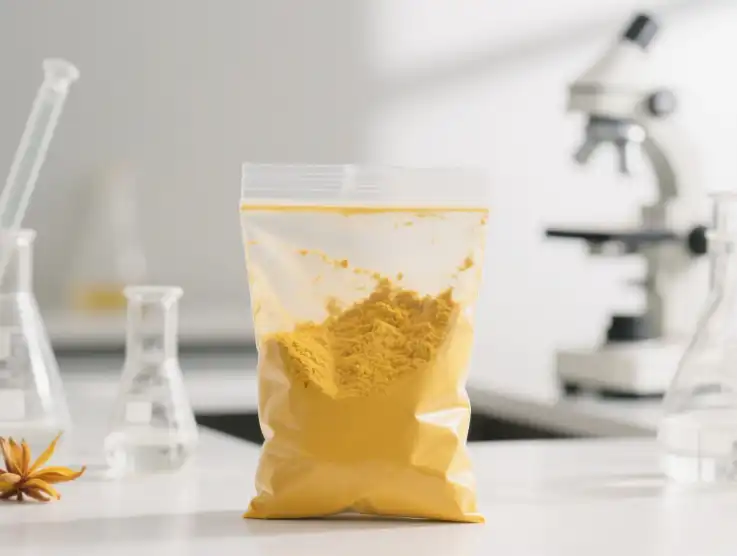
Gardenia Yellow Powder, derived from the fruit of the Gardenia jasminoides plant, is a natural food coloring and flavoring agent widely used in various industries. This vibrant yellow powder is not only prized for its ability to impart a beautiful golden hue to foods and beverages but also for its potential health benefits. In this blog post, we will explore the nutritional content of it, delving into its composition, potential health benefits, and various applications in the food and beverage industry.
What are the key nutrients found in Gardenia Yellow Powder?
Carotenoids and their antioxidant properties
Gardenia Yellow Powder is rich in carotenoids, particularly crocetin and crocin, which are responsible for its vibrant unheroic color. These composites are potent antioxidants that play a pivotal part in guarding the body against oxidative stress and free radical damage. The carotenoids set up in Gardenia Yellow Powder have been associated with colorful health benefits, including bettered eye health, reduced inflammation, and implicit cancer- fighting parcels. Studies have shown that the antioxidant capacity of these carotenoids may be similar to or indeed advanced than that of some well- known antioxidants like vitamin C and beta- carotene. Regular consumption of foods containing it may contribute to overall health and well- being by furnishing a natural source of these salutary composites.
Flavonoids and their potential health benefits
In addition to carotenoids, Gardenia Yellow Greasepaint contains a variety of flavonoids, which are factory- grounded composites known for their multitudinous health- promoting parcels. These flavonoids, including geniposide and gardenoside, have been studied for their implicitanti-inflammatory,anti-diabetic, and neuroprotective goods. Research has suggested that the flavonoids in it may help regulate blood sugar situations, reduce inflammation in the body, and potentially cover against neurodegenerative conditions. While further studies are demanded to completely understand the extent of these benefits, the presence of flavonoids in Gardenia Yellow Powder contributes to its overall nutritive profile and implicit health- promoting parcels.
Vitamins and minerals present in Gardenia Yellow Powder
Although not as concentrated as in some other food sources, it does contain small quantities of colorful vitamins and minerals that contribute to its nutritive value. These may include trace quantities of vitamin C, vitamin E, and certain B vitamins. also, the greasepaint may contain small amounts of minerals similar as potassium, calcium, and magnesium. While the situations of these nutrients may not be significant enough to calculate on Gardenia Yellow Powder as a primary source, they do contribute to the overall nutritive profile of the product. It's important to note that the exact vitamin and mineral content may vary depending on factors similar as the growing conditions of the Gardenia shops and the processing styles used to produce the greasepaint.
How does Gardenia Yellow Powder compare to other natural food colorants?

Comparison with turmeric and saffron
When comparing Gardenia Yellow Powder to other natural unheroic food colorings like turmeric and saffron, there are several factors to consider. Turmeric, deduced from the Curcuma longa factory, contains curcumin as its primary active emulsion, which is known for its stronganti-inflammatory and antioxidant parcels. Saffron, on the other hand, is deduced from the spots of the Crocus sativus flower and contains crocin, analogous to Gardenia Yellow Powder. In terms of color intensity, Gardenia Yellow Powder frequently provides a more stable and lustrously unheroic tinge compared to turmeric, which can occasionally conduct a slightly bitter taste. When compared to saffron, it is generally more cost-effective and easier to reference in large amounts, making it a popular choice for marketable food product. still, each of these natural colorings has its unique flavor profile and nutritive benefits, making them suitable for different culinary operations.
Stability and heat resistance of Gardenia Yellow Powder
One of the advantages of Gardenia Yellow Powder as a natural food color is its fairly high stability and heat resistance compared to some other natural options. The carotenoids in Gardenia Yellow Powder, particularly crocin, have been set up to be more stable under colorful processing conditions, including high temperatures and exposure to light. This stability makes Gardenia Yellow Powder a protean component in food manufacturing, as it can maintain its color and nutritive parcels indeed when subordinated to cuisine or baking processes. The heat resistance of Gardenia Yellow Powder allows it to be used in a wide range of operations, from ignited goods and confectionary to potables and dairy products, without significant loss of color or nutritive value.
Potential allergenicity and safety considerations
When considering the use of Gardenia Yellow Powder as a food color or nutritive supplement, it's important to address implicit allergenicity and safety considerations. Generally, Gardenia Yellow Powder is considered safe for consumption and has been used in traditional drug and culinary operations for centuries. still, as with any natural product, there's a possibility of antipathetic responses in some individualities. While disinclinations to Gardenia Yellow Powder are rare, it's always judicious for consumers with known factory disinclinations or perceptivity to exercise caution when trying new constituents. In terms of safety, Gardenia Yellow Powder has been approved for use as a food color in numerous countries, including Japan and corridor of Europe. still, nonsupervisory status may vary in different regions, so it's essential for manufacturers and consumers to be apprehensive of original regulations regarding its use in food products.
What are the potential health benefits of consuming Gardenia Yellow Powder?

Anti-inflammatory and antioxidant effects
Theanti-inflammatory and antioxidant parcels of Gardenia Yellow Powder have been the subject of multitudinous studies. The carotenoids and flavonoids present in the greasepaint, particularly crocin and geniposide, have demonstrated significantanti-inflammatory goods in both in vitro and in vivo studies. These composites may help reduce inflammation throughout the body, potentially serving conditions similar as arthritis, cardiovascular complaint, and certain types of cancer. The antioxidant capacity of Gardenia Yellow Powder is also noteworthy, as it may help cover cells from oxidative stress and free radical damage. This defensive effect could contribute to overall health and potentially decelerate down the aging process at a cellular position. While further exploration is demanded to completely understand the extent of these benefits in humans, theanti-inflammatory and antioxidant parcels of Gardenia Yellow Powder make it an intriguing subject for farther study in the field of nutrition and preventative drug.
Potential neuroprotective properties
Arising exploration has suggested that Gardenia Yellow Powder may retain neuroprotective parcels, potentially serving brain health and cognitive function. Some studies have indicated that the active composites in Gardenia Yellow Powder, particularly geniposide, may have defensive goods against neurodegenerative conditions similar as Alzheimer's and Parkinson's. These composites are allowed to work by reducing oxidative stress in the brain, inhibiting the conformation of dangerous protein summations, and promoting the survival of neurons. also, some beast studies have shown that Gardenia Yellow Powder may have mood- enhancing goods and could potentially be useful in the treatment of depression and anxiety. While these findings are promising, it's important to note that utmost of the exploration in this area has been conducted in laboratory and beast studies, and more mortal clinical trials are demanded to confirm these implicit neuroprotective benefits.
Effects on blood sugar regulation and diabetes management
Another area of interest regarding the health benefits of Gardenia Yellow Powder is its potential role in blood sugar regulation and diabetes management. Some studies have suggested that the active compounds in Gardenia Yellow Powder, particularly geniposide, may help improve insulin sensitivity and reduce blood glucose levels. This effect is thought to be due to the powder's ability to enhance glucose uptake in cells and stimulate insulin secretion from the pancreas. Additionally, some research has indicated that Gardenia Yellow Powder may help protect against diabetic complications by reducing oxidative stress and inflammation in various tissues. While these findings are promising, it's important to note that Gardenia Yellow Powder should not be considered a replacement for conventional diabetes treatments. Instead, it may be viewed as a potential complementary approach to managing blood sugar levels when used under the guidance of a healthcare professional.
Conclusion
Gardenia Yellow Powder is a fascinating natural ingredient with a rich nutritional profile and potential health benefits. Its carotenoids, flavonoids, and other bioactive compounds contribute to its antioxidant, anti-inflammatory, and potentially neuroprotective properties. While more research is needed to fully understand its effects on human health, Gardenia Yellow Powder shows promise in areas such as blood sugar regulation, brain health, and overall well-being. As a natural food colorant, it offers a stable and versatile alternative to synthetic options, making it valuable in the food and beverage industry. If you are also interested in this product and want to know more product details, or want to know about other related products, please feel free to contact lea_slsbio@163.com,WhatsApp+86 13193326505.
References
- Zhang, L., et al. (2019). "Phytochemical and pharmacological properties of Gardenia jasminoides: A review." Journal of Ethnopharmacology, 242, 112042.
- Gao, L., et al. (2018). "Crocin, a major component of saffron, attenuates cognitive deficits in streptozotocin-induced diabetic rats." Neurochemical Research, 43(5), 1024-1033.
- Chen, Y., et al. (2020). "Geniposide: A review of its pharmacology, pharmacokinetics, and toxicity." Phytotherapy Research, 34(8), 1895-1916.
- Xu, H., et al. (2017). "Gardenia yellow pigment as a novel natural colorant: A review." Comprehensive Reviews in Food Science and Food Safety, 16(6), 1297-1309.
- Wang, J., et al. (2018). "Neuroprotective effects of geniposide in Alzheimer's disease models." Biomedicine & Pharmacotherapy, 108, 1038-1045.
- Liu, H., et al. (2016). "Antidiabetic effect of Gardenia jasminoides Ellis fruit extracts in L6 myotubes and diabetic mice." Journal of Ethnopharmacology, 192, 256-263.

